Bringing a touch of the wild indoors is one of the most rewarding design trends of recent years. A living room filled with lush greenery — often called a “mini indoor jungle” — doesn’t just make your home look stunning; it also improves air quality, reduces stress, and reconnects you with nature. Creating your own mini jungle might sound complicated, but with a thoughtful approach and the right plants, anyone can transform their living room into a green oasis.
In this detailed guide, you’ll learn how to design, arrange, and maintain your own indoor jungle naturally — even if you’re a beginner.
1. Why Create a Mini Jungle Indoors?
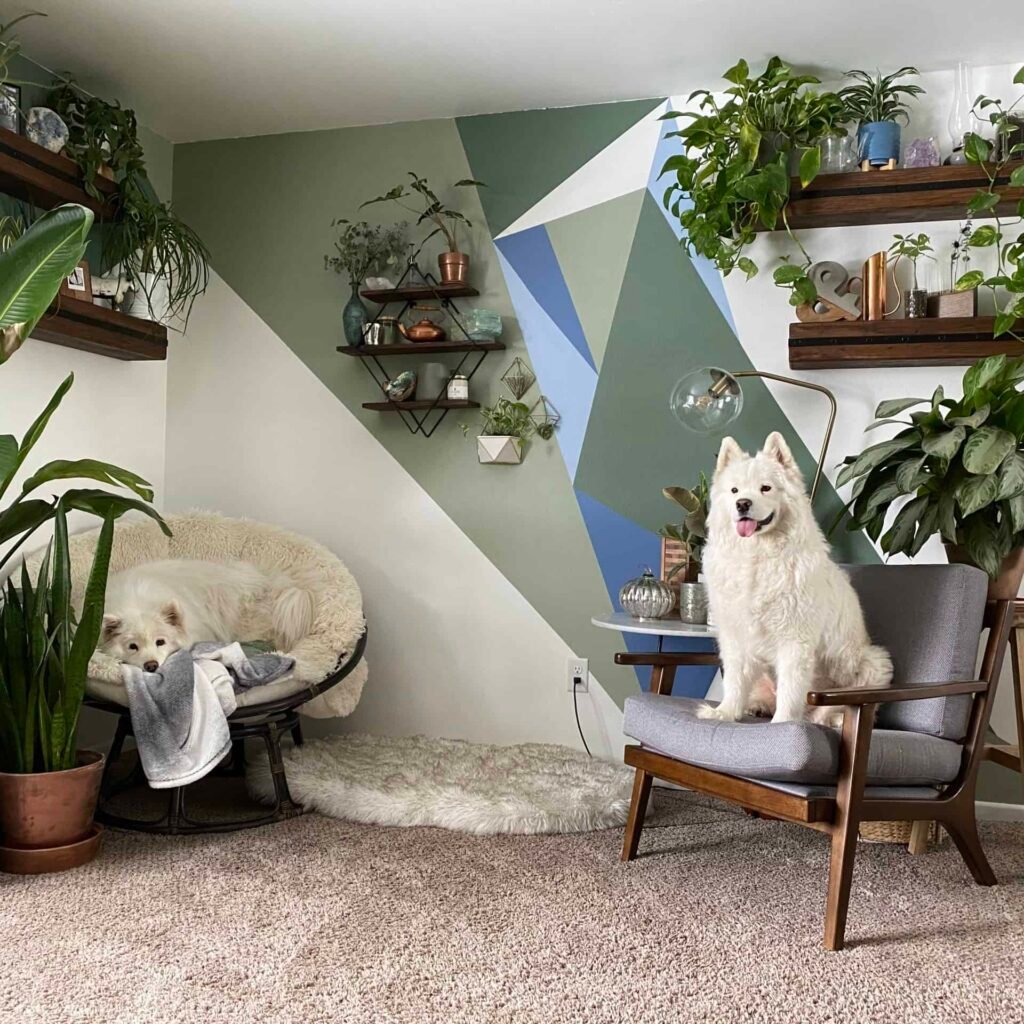
Before diving into the “how,” it’s worth exploring the “why.” Indoor jungles are more than a décor trend; they’re a lifestyle statement and a wellness choice.
Here are some powerful reasons to create your own mini jungle:
- Cleaner Air: Many houseplants absorb toxins like formaldehyde, benzene, and carbon dioxide, leaving your indoor air fresher.
- Stress Reduction: Studies show that being surrounded by plants lowers cortisol (stress hormone) levels and boosts mental well-being.
- Natural Humidity: Plants release moisture through transpiration, helping balance humidity in your home — especially helpful in dry climates.
- Aesthetic Appeal: A living room filled with vibrant foliage creates a relaxing, exotic vibe that elevates your home’s personality.
- Connection with Nature: Indoor jungles bring nature closer, fostering mindfulness and a sense of peace.
With benefits like these, it’s easy to see why so many people are turning their homes into natural sanctuaries.
2. Planning Your Indoor Jungle Design
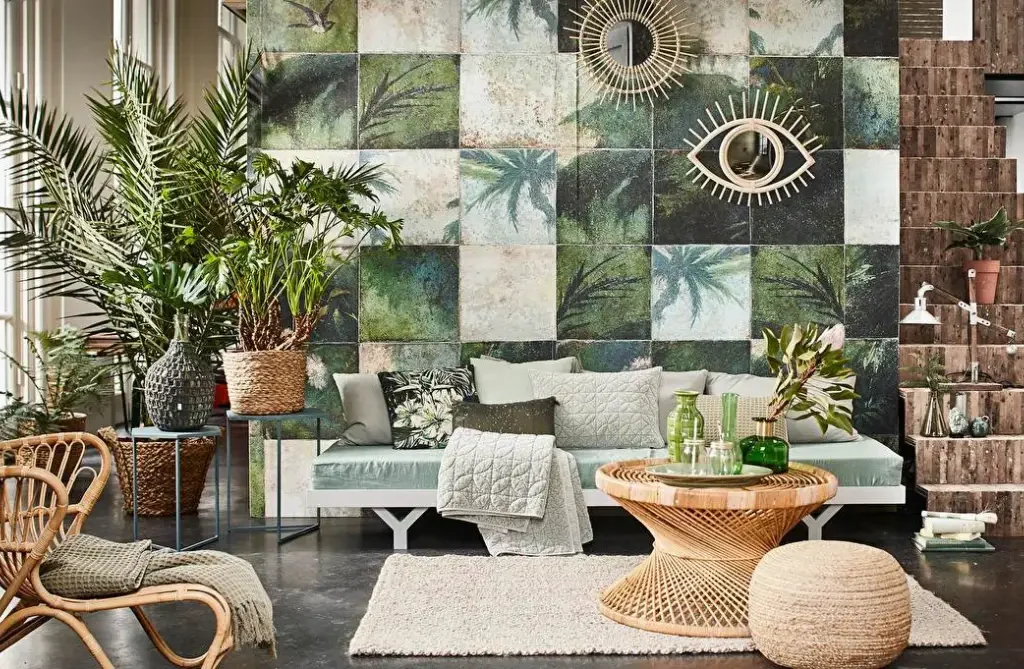
Before buying plants, plan your indoor jungle layout. Think of it as designing a layered ecosystem rather than a simple plant collection.
a) Assess Your Living Room Environment
- Light: Observe how much natural light your room receives. South- or west-facing windows provide bright light; north-facing rooms may need grow lights.
- Temperature: Most houseplants thrive between 65–80°F (18–27°C).
- Humidity: Jungle plants love moisture. If your air is dry, consider using a humidifier or pebble trays.
b) Define the Style You Want
Your mini jungle can reflect your personality. Here are a few popular styles:
- Tropical Paradise: Filled with large-leaf plants like Monstera, Bird of Paradise, and Philodendrons.
- Bohemian Jungle: A mix of climbing, hanging, and trailing plants with woven baskets and natural textures.
- Minimalist Green Corner: Fewer plants but with striking shapes and bold foliage.
c) Choose the Layout
- Corner Jungle: Concentrate your plants in one lush corner of the living room.
- Ceiling-to-Floor Design: Use tall plants, hanging vines, and small tabletop species for full visual impact.
- Shelf Display: Layer different plants on open shelves for a vertical jungle effect.
Sketch a rough layout before you start placing plants.
3. Choosing the Right Plants for a Mini Jungle
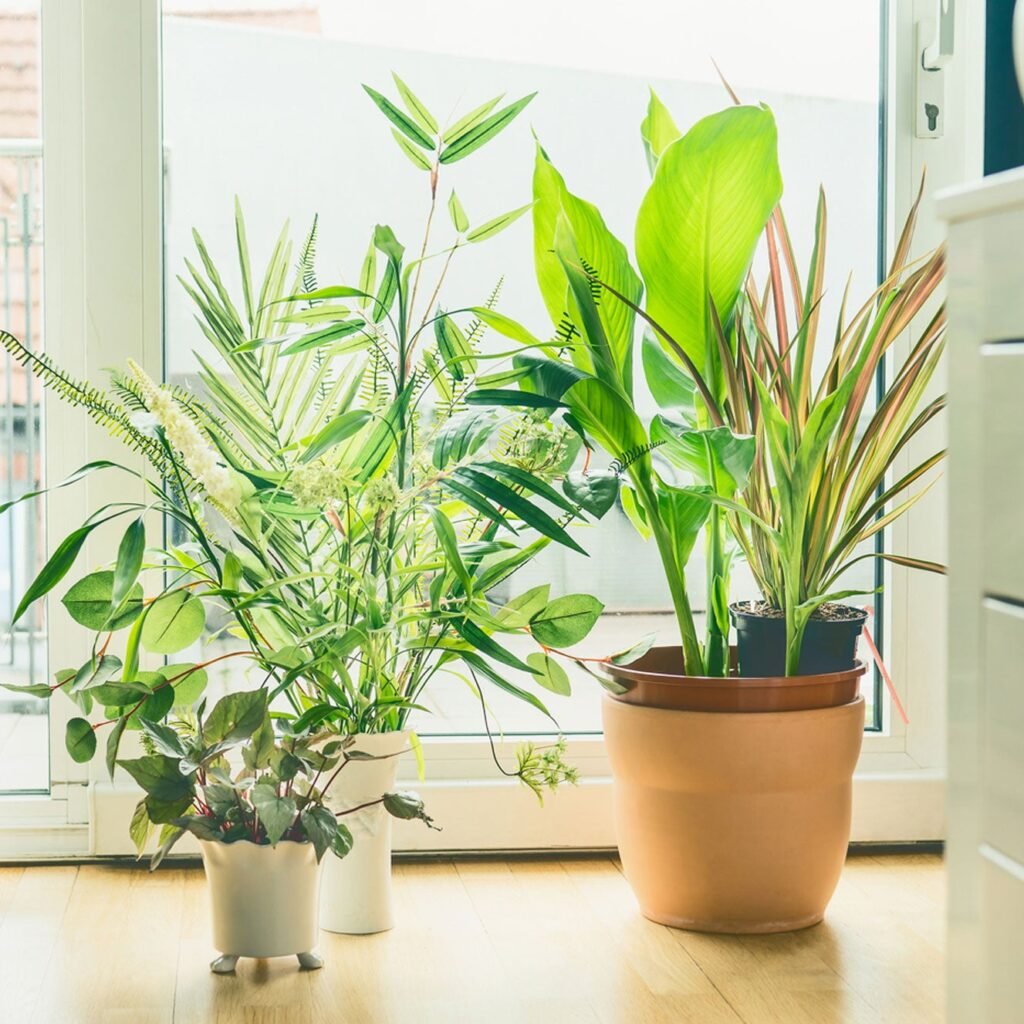
The success of your indoor jungle depends largely on the plants you choose. The goal is to mix variety, texture, and color while ensuring they all thrive in similar light and humidity conditions.
a) Tall Statement Plants
These form the “trees” of your jungle — the backbone of your design.
- Monstera deliciosa (Swiss Cheese Plant): Iconic split leaves and tropical appeal.
- Bird of Paradise: Adds height and a bold, architectural look.
- Fiddle Leaf Fig: Perfect for corners, but needs bright indirect light.
- Areca Palm or Kentia Palm: Elegant, airy fronds that create a true jungle vibe.
b) Mid-Height Bushy Plants
These fill out the middle layer and create lush density.
- Philodendron: Easy to grow and comes in climbing or upright varieties.
- Calathea: Beautiful patterned leaves, great for medium light.
- Peace Lily: Adds elegance and even blooms indoors.
- Dieffenbachia: Large variegated leaves and easy maintenance.
c) Trailing and Hanging Plants
For vertical appeal and depth.
- Pothos (Devil’s Ivy): Fast-growing, low-maintenance, and perfect for shelves.
- Spider Plant: Excellent air purifier with cascading shoots.
- English Ivy: Great for draping across mantels or hanging baskets.
- String of Hearts or String of Pearls: Adds charm and movement.
d) Small Accent Plants
These add variety to tabletops and small spaces.
- Fittonia (Nerve Plant): Brightly veined leaves for pops of color.
- Baby’s Tears: Soft ground-cover effect for pots or terrariums.
- Succulents or Mini Ferns: Great for small planters.
When choosing, try to include plants with different leaf shapes, heights, and textures to create that lush jungle diversity.
4. Layering: The Secret to a Real Jungle Look
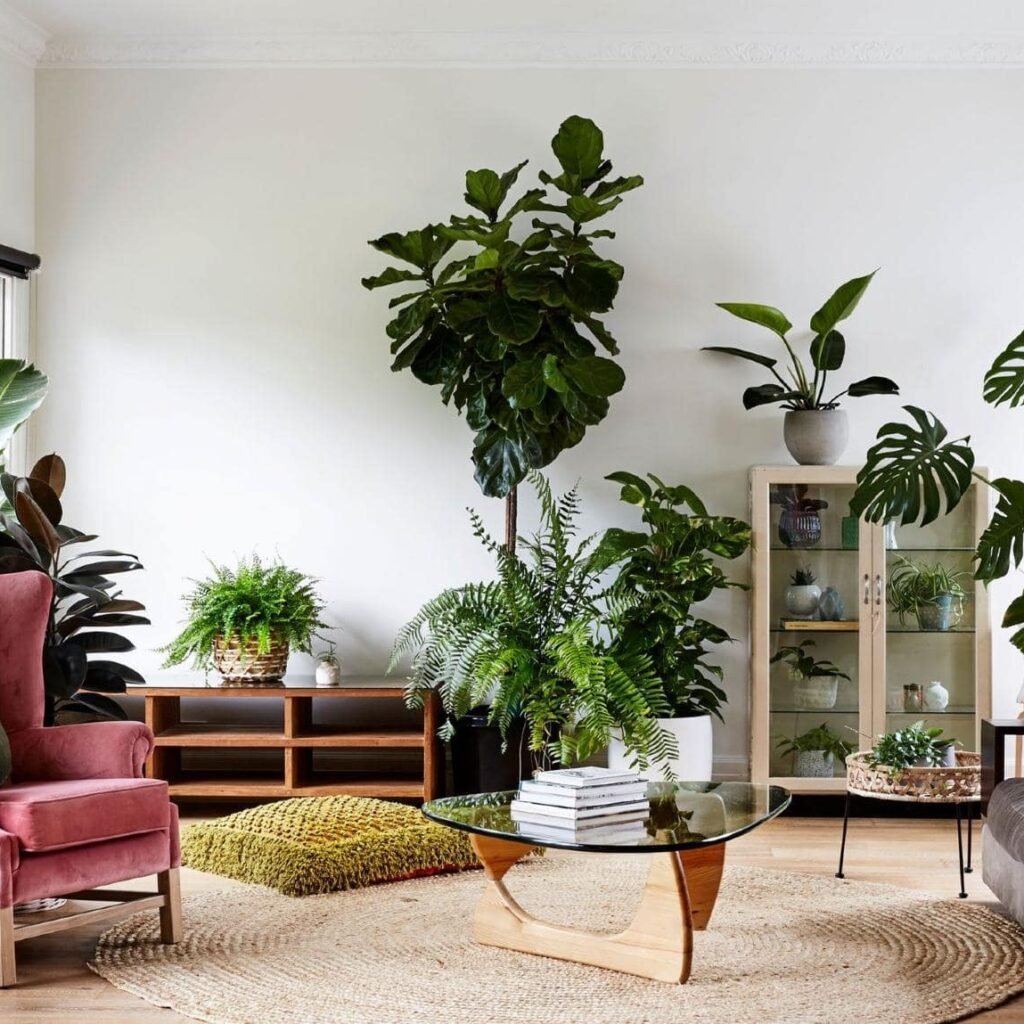
Nature doesn’t grow in neat rows — and neither should your indoor jungle. Layering is key to creating depth and a sense of abundance.
Here’s how:
- Back Layer (Tall Plants): Place your large plants like Monsteras or Palms near walls or corners.
- Middle Layer (Medium Plants): Arrange bushy plants at sofa or table height for fullness.
- Front Layer (Small and Trailing Plants): Add smaller pots or trailing plants that cascade over shelves or stands.
- Vertical Layer: Use hanging planters, macramé holders, or wall shelves for height variation.
Mix heights, textures, and pot styles for a dynamic and natural flow.
5. Creating the Perfect Environment
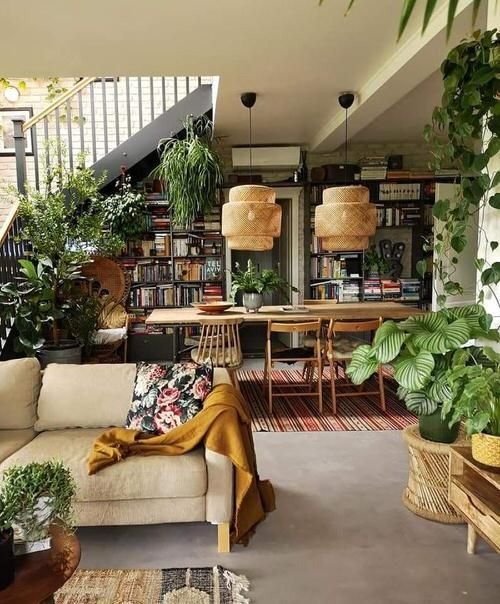
To make your jungle flourish, you must recreate the conditions of a tropical forest — warmth, moisture, and indirect sunlight.
a) Light
- Place most plants near east- or south-facing windows for bright, indirect light.
- For low-light corners, add LED grow lights to mimic natural sunlight.
- Rotate plants every few weeks for even growth.
b) Humidity
Jungle plants thrive in humidity levels of 50–70%.
- Use a humidifier during dry months.
- Place pebble trays with water near plants.
- Group plants together — they naturally increase each other’s humidity through transpiration.
c) Watering
- Keep soil evenly moist, not soggy.
- Use filtered or rainwater if possible — some tropical plants are sensitive to chlorine.
- Mist leaves occasionally to mimic rainforest conditions.
d) Temperature
Avoid cold drafts or heat from vents. Keep your jungle cozy between 65–80°F (18–27°C).
6. Styling Your Mini Jungle
Once your plants are chosen and arranged, styling them beautifully makes all the difference.
a) Choose Natural Materials
Use earthy, organic textures that complement greenery:
- Woven baskets, terracotta pots, wooden stands, or rattan furniture.
- Avoid too much plastic — it breaks the natural feel.
b) Use Multi-Level Displays
Varying heights give your space dimension. Combine floor plants with hanging ones, and use plant stands or shelves for vertical layering.
c) Add Decorative Touches
- Fairy lights or warm LED strips for soft nighttime ambiance.
- A small water feature or humidifier for atmosphere and moisture.
- Mirrors to reflect light and make your jungle look more expansive.
d) Blend with Your Décor
Choose pots and planters that complement your living room’s color scheme — earthy tones, whites, and neutrals work best for a natural look.
7. Maintenance Tips for a Thriving Indoor Jungle
A mini jungle is alive and ever-changing. Consistent care keeps it lush and vibrant.
a) Clean the Leaves
Dust blocks light and slows growth. Wipe leaves gently with a damp cloth every 2–3 weeks to keep them breathing freely.
b) Rotate and Prune
Rotate plants for even sunlight exposure and trim yellow or overgrown leaves to encourage fresh growth.
c) Feed Naturally
Use organic fertilizers like compost tea, banana peel water, or seaweed solution once a month during spring and summer.
d) Watch for Pests
Inspect leaves regularly for pests like spider mites or mealybugs. Treat naturally with neem oil spray or insecticidal soap.
e) Repot When Needed
Every 1–2 years, refresh the soil and move plants to slightly larger pots to support growth.
8. Embrace Imperfection — Let Nature Take Over
Part of the beauty of an indoor jungle lies in its wildness. Allow plants to grow freely, intertwine, and create natural layers. Don’t strive for perfect symmetry — jungles thrive in organic chaos.
Remember, each plant grows at its own pace. Some will flourish quickly, while others take time. The goal isn’t perfection — it’s harmony.
9. The Emotional Impact of Living with a Mini Jungle
Living among plants changes more than just your home’s aesthetics — it transforms your mood and mindset. A mini jungle offers:
- Peaceful Energy: Greenery has a calming psychological effect, helping you unwind after a busy day.
- Creativity Boost: The natural environment inspires focus and imagination.
- Mindful Living: Caring for plants encourages patience, observation, and connection with nature.
Your living room becomes not just a physical space but a sanctuary of growth and tranquility.
10. Conclusion
Creating a mini jungle in your living room is more than a design project — it’s a journey toward a greener, calmer, and more vibrant lifestyle. With careful plant selection, thoughtful layering, and a nurturing touch, you can bring the magic of the rainforest right into your home.
Your indoor jungle will reward you with lush beauty, cleaner air, and a daily reminder of the serenity that only nature can offer. Whether your space is large or small, every leaf, vine, and frond adds life to your living room — turning it into a lush retreat you’ll never want to leave.
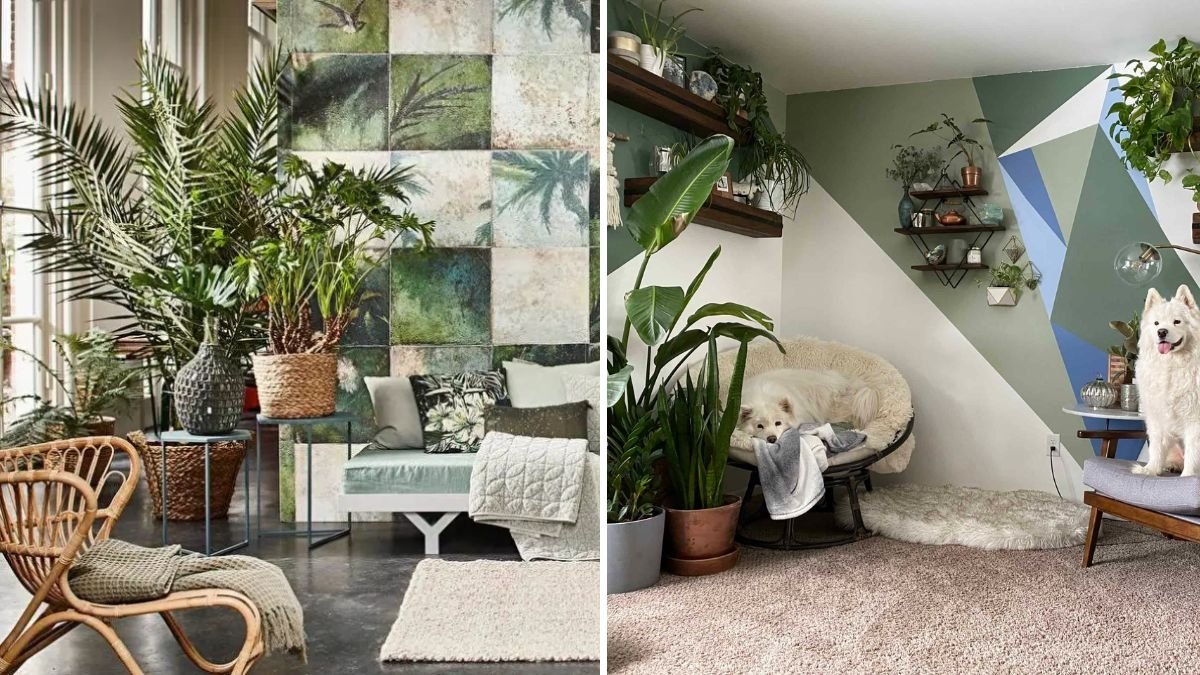




Leave A Comment